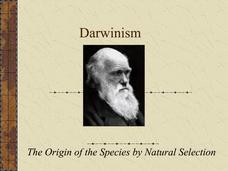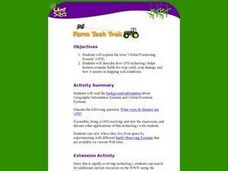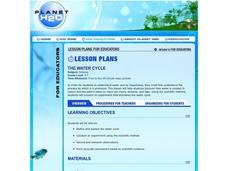Curated OER
Build Illinois
Students examine the history of the formation of Illinois. Traveling virtually between time periods, they describe each period and compare them with how Illinois is now. They work together to complete an activity and worksheet.
Curated OER
Seeking a Fortune in 18th Century Maritime Boston
Study the Revolutionary War era practice of recruiting seamen to prey upon the British shipping industry, and discuss the impact this practice had on the Colonial war efforts. Learners read and interpret recruiting advertisements for...
Curated OER
Mineral Magic
Students classify rocks and minerals according to their characteristics, after finding the similarities and differences of school supplies and pasta.
Curated OER
Scatter Plots
Seventh graders investigate how to make and set up a scatter plot. In this statistics lesson, 7th graders collect data and plot it. They analyze their data and discuss their results.
Curated OER
Darwinism: The Origin of the Species by Natural Selection.
The Darwin PowerPoint covers many of the Scientists that worked on similar concepts to Darwin and that were involved with famous theories. students are informed about the basic thinking behind natural selection and examples of...
Curated OER
WHO Wants Clean Water! Do You? Solving Conflicts Over International Water Rights Issues
High schoolers examine the water rights on an international scale. In this social studies lesson plan, students research on a specific water rights issue. They write a paper about their findings and create a PowerPoint presentation which...
Curated OER
This Great Enterprise”: Theodore Roosevelt and the Panama Canal
Students explore the implications of the "Great Enterprise." In this Panama Canal lesson plan, students listen to their instructor present a lecture regarding President Teddy Roosevelt and Panama Canal. Students respond to discussion...
Curated OER
Images of Katrina
Students use maps and online data to find specific geographic areas. In hurricane Katrina lesson students use aerial photographic imagery to see some impacts of hurricane Katrina.
Curated OER
Captain Cook in Hawaii
Young scholars research Captain Cook and why he died and create a radio program script of the announcement of his death. In this Captain Cook lesson plan, students are given pictures, letters, and background information for their research.
Curated OER
Fish Workings
Learners observe, hypothesize, and draw conclusions regarding fish. They examine their anatomy, and how they function in their environment.
Curated OER
Up, Up, and Away
Students create a model to explore the water cycle. Students also perform different experiments to witness water changing from a liquid to a gas. Students are asked to if they can find ways for water to go away without pouring the...
Curated OER
The Water Cycle
Students research the water cycle and identify main vocabulary associated with the water cycle. They build and observe a closed system model that demonstrates the water cycle in action.
US Geological Survey
U.s. Geological Survey: The Water Cycle: The Oceans
Through pictures, diagrams, and charts, learn how the ocean serves as a storehouse of water.
Indiana University
Indiana Univ. Bloomington: Geo Notes: Trilobites: Denizens of Ancient Seas [Pdf]
Presents some facts about trilobites, extinct arthropods from the Cambrian to Permian Periods.
Other
Aurora Trust and Aurora Institute of Maritime Studies
Find out about human interaction with the world's oceans through education support activities in the fields of ocean exploration, research, and education.
PBS
Nh Pbs: Nature Works: Ocean Zones
Discover more about the underocean environment at this site that surveys animals, environmental factors such as light and temperature, currents, animals, plants, and the like.
US Geological Survey
Usgs: Mid Oceanic Ridge
This site from USGS provides a map of the mid-oceanic ridge in the sea floor of oceans.
Columbia University
Scientific Background on the Indian Ocean Earthquake and Tsunami
This site features information and related links that can be used by students and scientists to understand the events that led to the December 2004 Indian Ocean tsunami.


















